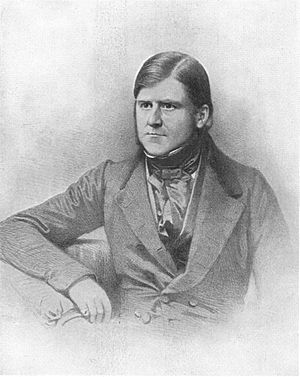John Dalrymple (physician) facts for kids
Quick facts for kids
John Dalrymple
|
|
|---|---|

John Dalrymple, lithograph
|
|
| Born | April 17, 1804 Norwich, United Kingdom
|
| Died | 2 May 1852 (aged 48) London, United Kingdom
|
| Education | University of Edinburgh |
| Years active | 1827-1852 |
| Known for | Bence Jones protein, Dalrymple's sign |
| Relatives | William Dalrymple (surgeon) (father) |
| Medical career | |
| Profession | Surgeon |
| Institutions | Royal London Ophthalmic Hospital |
| Sub-specialties | Ophthalmology |
| Research | Ophthalmology, Histology |
John Dalrymple (born April 17, 1804 – died May 2, 1852) was an important English eye doctor, also known as an ophthalmologist. He was born in Norwich, England. His father, William Dalrymple, was also a surgeon.
John studied medicine at the University of Edinburgh. After graduating in 1827, he became an eye surgeon. He worked at the Royal London Ophthalmic Hospital.
Contents
John Dalrymple's Medical Career
John Dalrymple quickly became a respected surgeon. In 1832, he was chosen as an assistant surgeon. He became a full surgeon in 1843.
His hard work and discoveries led to more honors. In 1850, he was made a fellow of the Royal Society. This is a very important group for scientists. The next year, he joined the council of the Royal College of Surgeons of England.
Discovering Bence Jones Protein
John Dalrymple is well-known for his work with Henry Bence Jones. They studied the tiny structures of tissues, a field called histology. Together, they found a special type of protein. This protein is now called Bence Jones protein.
This protein is often found in the blood and urine of people with a serious illness. The illness is called multiple myeloma. Dalrymple wrote about his findings in a book. It was titled On the microscopic character of mollities ossium.
Important Books and Dalrymple's Sign
Dalrymple also wrote two very important books about eye health. One was called "The anatomy of the human eye" (1834). The other was "Pathology of the human eye" (1852). These books helped other doctors learn about the eye.
A medical sign is named after him, called Dalrymple's sign. This sign describes when someone's eyelids are unusually wide open. This can happen in a condition called exophthalmic goiter.
Later Life and Legacy
John Dalrymple passed away on May 2, 1852. He was buried next to his father, William. Their graves are in the Terrace Catacombs. These are located on the western side of Highgate Cemetery in London. His work greatly helped our understanding of eye diseases.

